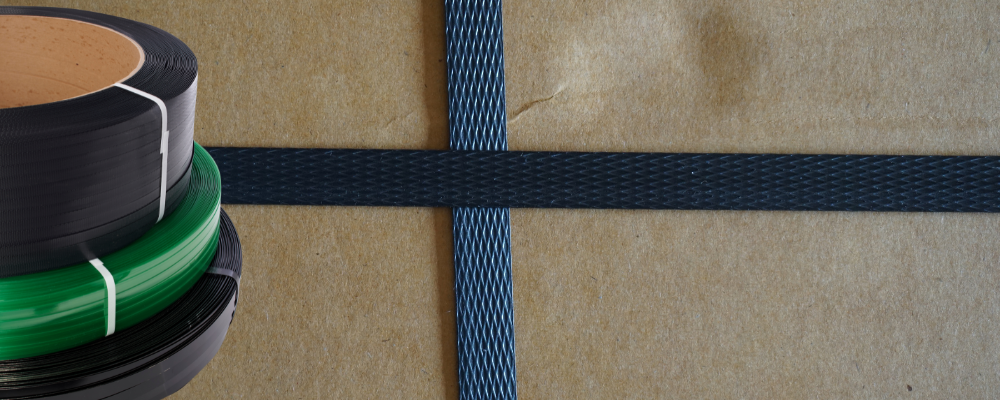By Sam Singer | December 19, 2023 0 Comments

Steel to Plastic Strapping
As the world continues to prioritize sustainability and cost-efficiency, businesses are constantly seeking alternatives to traditional packaging materials. One product that has gained significant popularity in recent years is PET strapping, offering a viable, affordable, and eco-friendly solution to steel strapping. Polyester strapping, also known as PET, is the most durable plastic strapping material compared to polypropylene strapping. By considering the advantages and features of PET strapping, businesses can make an informed decision on whether to switch from steel to this more efficient and sustainable option. So let's take a closer look at why PET strapping is becoming the preferred choice for packaging needs.
Benefits of PET Strapping over Steel Strapping
When it comes to transporting heavy goods, secure strapping is primitive to prevent damage during transit. For years, steel strapping has been the go-to choice, but let's talk about why PET strapping might be the better option. PET strapping is highly durable and has a high tensile strength, so it can handle even the heaviest loads without breaking or snapping. Additionally, it is lightweight and flexible, making it easier and safer to handle during the strapping process. Unlike steel strapping, PET strapping is also non-corrosive and weather-resistant, which is a huge advantage if your goods are being transported overseas or across long distances. Overall, switching to PET strapping will not only save you time and effort but also prevent any damage to your products.
i. Cost Savings
One of the major advantages of PET strapping over steel strapping is its cost-effectiveness. While steel strapping may seem cheaper, the hidden costs associated with it can add up quickly. For instance, steel strapping requires specialized tools and equipment for handling and sealing, increasing your initial investment. On the other hand, PET strapping can be easily handled and sealed using simple tools, reducing the need for expensive equipment. Additionally, the lightweight nature of PET strapping also results in lower shipping costs, making it a more cost-efficient option in the long run.
ii. Efficiency
Another significant benefit of PET strapping is its efficiency in the packaging and shipping process. As mentioned earlier, PET strapping is lightweight and flexible, making it easier to handle and maneuver during the strapping process. This not only saves time but also reduces the risk of injuries for workers handling the strapping. Also, PET strapping does not require pre-tensioning like steel strapping, which can be a time-consuming and labor-intensive process. This means that with PET strapping, you can complete the packaging process faster and more efficiently, allowing for quicker turnaround times and increased productivity.
iii. Eco-Friendly
Aside from cost and efficiency, another significant factor driving the switch to PET strapping is its eco-friendliness. As businesses become more environmentally conscious, it is essential to consider sustainable packaging options. Unlike steel strapping, which often ends up in landfills after use, PET strapping is 100% recyclable and can be reused multiple times without losing its strength and durability. By using PET strapping, businesses can reduce their carbon footprint and contribute to a more sustainable future.
When to Use Steel vs. Plastic Strapping
When it comes to choosing between steel or plastic strapping, it can sometimes be a tough decision. Steel strapping provides exceptional strength and durability, making it an excellent choice for heavy-duty applications. It can handle extreme tension and can resist harsh environmental factors. On the other hand, plastic strapping is lightweight, affordable, and well-suited for lighter loads or products that won't be exposed to extreme conditions. It's also more flexible than steel strapping, making it easier to work with and wrap around oddly shaped items. Ultimately, the decision on which strapping to use will depend on the specific needs of your business and the products you're packaging.
Different Types of PET Straps Available
PET straps have become increasingly popular over the years as a more sustainable and affordable alternative to traditional plastic straps. There are various types of PET straps available on the market, each with its unique properties that make them suitable for different applications. For example, embossed PET straps are designed to offer a stronger grip and prevent slippage, whereas smooth PET straps are perfect for high-speed machine applications. Other options include colored PET straps for branding purposes and ultraviolet-resistant PET straps for outdoor use. With all these options available, it's important to consider the requirements of your specific application to determine which type of PET strap will work best for you.
How to Choose the Right PET Strap for Your Needs
When it comes to choosing the right PET strap for your needs, there are a few important factors that you need to consider. First and foremost, you need to decide on the width and thickness of the strap. This will depend on the weight and size of the items that you will be securing. Another key consideration is the breaking strength of the strap – you want to make sure that it can handle the weight of your cargo. You will also need to think about the environment in which you will be using the strap, whether it is indoors or outdoors, and whether it will be exposed to extreme temperatures or moisture. By taking these factors into account, you can select the perfect PET strap for your needs and ensure that your cargo is securely transported every time.
In conclusion, PET strapping offers an increasingly popular solution to steel strapping in many industries. Not only is it a higher quality product for a lower cost, it is easier to use, and is an eco-friendly alternative to steel strapping. When deciding between steel vs. plastic strappings for your uses, it is important to consider your specific needs as there are a range of product types and sizes available. While PET strapping may be the best choice for most applications, steel strapping should still be considered for heavier applications or where a high tension or extra firm hold is required. At the end of the day, the choice between steel and PET strapping ultimately depends on the specific needs of a business or application.
If You Want to Make The Switch to PET Strapping, Contact One of Our Experts Today!

About the Author: Sam Singer
Sam leads the sales and marketing efforts for Rapid Packaging. His career has taken him all over the country, living in 5 states and 3 regions in the past 12 years. A native of California, he is a graduate of the University of Portland (Portland, OR).
Before entering the packaging industry, Sam spent 25 years in wireless technology, leading teams regionally and nationally.
Sam’s approach to packaging is to focus on building solutions for customers. He has a rigorous focus on continuous improvement for customer value-add. He enables the sales force to support client needs by initiating ongoing training and skill development.
Sam lives in St. Paul, MN, with his wife and youngest of 5 children. He was proudly promoted to Grandpa in January 2021.
Need Help?
Increase your productivity with entry-level of full-line packaging automation, reduce packaging costs, and increase product protection with a full catalog of packaging supplies.